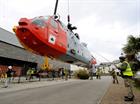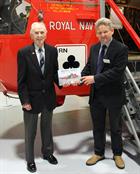CULDROSE SEA KING THE STAR OF MUSEUM’S SEARCH AND RESCUE DISPLAY
A Search and Rescue Sea King which saw active service in a dramatic rescue of British Forces during the Falklands War is the leading attraction of a new interactive exhibition at the Fleet Air Arm’s Museum inSomerset.
Chronicling a history of the Royal Navy’s dedication to rescues from the air - Saved! "100 Years of Search and Rescue" - was officially opened by TV presenter Jules Hudson and legendry Royal Navy aviator, Captain Eric 'Winkle' Brown CBE DSC AFC.
The Exhibition is being staged at a significant time as the venerable Sea King is being 'stood down' from its operation duties with the Royal Navy's Search and Rescue force. As a faithful workhorse of airborne rescue services for the past 45 years, Sea King - XV663 has been affectionately christened by museum staff and public the 'Banana Split', as she is painted half red & grey and yellow, signifying the unique service Sea Kings have given to both the Royal Navy and RAF. The arrival of the aptly named aircraft provides a first class 'walk-though and hands on' experience for both young and old.
70 feet long, 16 feet high and six tonne, XV 663 was previously an outstanding success at Falmouth’s National Maritime Museum, where during her three years spell in the limelight, over half a million visitors climbed all over her.
Prior to becoming a museum celebrity XV663 had a long and distinguished naval career. Her first flight was on April 15 1970 and she served during the Falklands War with 825 Naval Air Squadron. The Aircraft proved her worth on the afternoon of June 8 1982 when operating alongside other Sea Kings went to the aid of Royal Fleet Auxiliary landing ship Sir Galahad.
Three bombs had scored direct hits on the heavily laden troop ship and XV 663 lifted a significant number of Welsh Guardsmen, who were waiting to disembark, clear and to safety. Following her service in the South Atlantic she returned toCornwalland operated mainly at RNAS Culdrose with 820 NAS until her retirement in 2000.
"I was involved in some of the very first helicopter rescues in the Royal Navy, working solo as a pilot operating both winch and flying the aircraft," said Capt Eric Brown addressing an enthralled audience gathered for the grand opening. "SAR missions nowadays involve a team effort; pilot, observer and aircrewman as well as a large support crew back at base. XV663 is set to be a very popular attraction for the Fleet Air Arm Museum."
Dave Morris, Curator of Aircraft at the FAA Museum has also written a book to complement the ‘100 years of Search and Rescue’ exhibition and was on hand to sign copies along with Capt ‘Winkle’ Brown.





